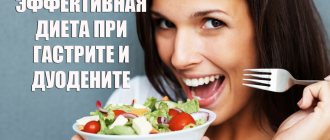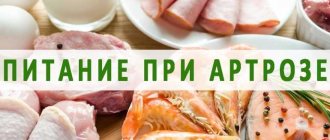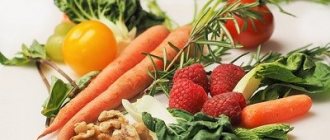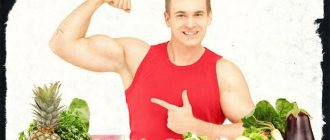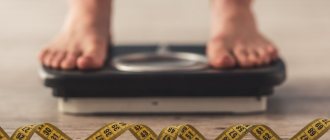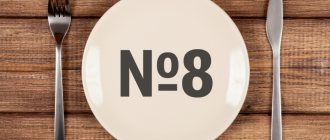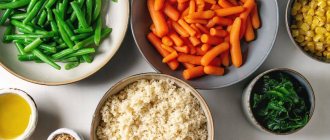Any parent at least once in his life has encountered such a problem as indigestion in a child. Diarrhea can strike you by surprise at any time. This cannot be left unattended under any circumstances. It should be remembered that complex treatment is necessary. A properly selected diet for diarrhea in a child is one of the most important conditions for recovery and restoration of normal functioning of the gastrointestinal tract.
Nutrition for diarrhea in children
Follow these 6 principles of healthy eating:
- Fractional nature of nutrition. The main principle is to feed the baby often and in small portions.
- The preferred method of cooking is boiling, stewing, baking. Fried, spicy, salty, smoked foods, which additionally irritate the intestines, are not allowed.
- During the cooking process, all products must be thoroughly washed or heat treated to prevent additional infection.
- Dishes should not be varied or multi-component. It is better if the child eats one, maximum two foods at one meal. In this case, food digestion will be easier.
- The temperature of the cooked dishes should be warm, that is, not very cold or hot. This rule also applies to drinks.
- It is necessary to take plenty of fluids. With diarrhea, severe dehydration occurs in the body, and for rapid recovery it is necessary to replenish the body's water balance. It is necessary to offer the child warm water or compote every hour. If the baby does not yet drink from a cup himself, you can give him water from a spoon or using a syringe without a needle. It is important to remember that the risk of dehydration during diarrhea is especially high in infants under one year of age due to their low weight.
Such nutrition will contribute to the rapid restoration of intestinal microflora and normalization of stool.
Causes
Common causes of diarrhea:
- viral infections (rotavirus, adenovirus, norovirus);
- bacterial infections (E. coli, salmonella, shigella, campylobacter);
- parasitic infections (cryptosporidium, lamblia);
- food allergies and intolerances;
- food poisoning;
- use of antibiotics:
- irritable bowel syndrome (IBS), celiac disease, Crohn's disease.
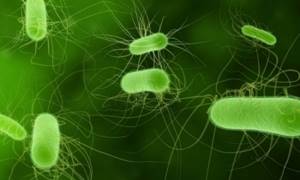
What foods to give for diarrhea with vomiting?

During this period, you only need to restore the water balance, and you need to give them drinks in small portions (for infants, a teaspoon) so as not to provoke an attack of vomiting.
Attention! No medications that block vomiting should be given without consulting a doctor!
Using diet to diagnose the causes of chronic diarrhea
When your doctor suspects that diarrhea is caused by a food intolerance or allergy, he or she will ask you to avoid foods that contain:
- lactose, which is present in dairy products and leads to diarrhea in children with lactase deficiency;
- carbohydrates;
- gluten contained in barley, rye, wheat (if the doctor suspects celiac disease);
- other substances.
This is to see if diarrhea improves with dietary changes.
What can you eat?
What foods are allowed to be given to a child for diarrhea, depending on his age:
- If a child is exclusively breastfed under one year old, you should continue to breastfeed him, but you should not allow him to overeat so as not to overload the gastrointestinal tract. It is better to breastfeed more often, but for a short time.
- It is also advisable for a nursing mother to exclude foods that contribute to gas formation and stool thinning (legumes, all fresh vegetables, especially white cabbage, fermented milk products, fresh fruits).
- If the child is bottle-fed, you need to feed him mixtures with prebiotics to restore the intestinal microflora. The portions also need to be reduced a little, but the mixture should be given more often.
- An older baby who is already eating complementary foods can be fed, in addition to breast milk or formula, rice porridge without milk, boiled pasta without sauce, and hard-boiled eggs. However, if the proportion of breast milk or formula is higher than the proportion of complementary foods in the baby’s diet, it is better to temporarily exclude complementary foods until stool normalizes.
- An older child, who has already completely switched to a common table, is allowed to feed the following foods: dairy-free porridge, especially rice, low-fat broth, lean meat and fish (boiled or baked), boiled pasta, bananas in small quantities, pureed low-fat cottage cheese, low-fat omelette, crackers, dry Lenten cookies.
- The following drinks are allowed: berry juice and compote, weak tea, berry jelly, weak rosehip infusion, chamomile infusion.
It is important to follow this diet for as long as possible (at least two weeks), and not return to your usual diet as soon as the diarrhea passes.
Symptoms
In addition to loose stools, diarrhea is also associated with other digestive symptoms, including:
- colic;
- bloating and pain;
- release of gases from the intestines;
- frequent visits to the toilet;
- nausea;
- vomit;
- fever.
If your child has diarrhea, do not hesitate to contact your doctor for advice. Diarrhea is especially dangerous in newborns and infants, as it can lead to dehydration in just a day or two. The death of a child from loss of fluids can occur within a few days.
Forbidden food
If you have diarrhea, the following foods should not be given to a child of any age:
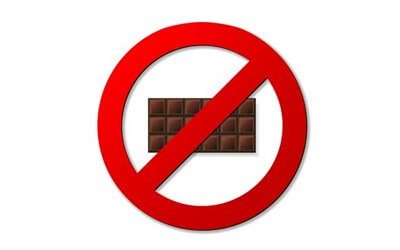
- fresh bakery;
- sausage and frankfurters;
- spices and seasonings;
- sweets (sweets, chocolate);
- legumes and mushrooms in any form;
- fatty fried meat or fish;
- carbonated drinks, strong tea, coffee, cocoa;
- fermented milk products (kefir, fermented baked milk, yogurt) and milk;
- canned and pickled foods (pickles, canned fish);
- fresh fruits, vegetables and dried fruits, especially those that contain a lot of fiber (apples, cabbage, cucumbers, beets, prunes).
Interesting article: What can a child eat after vomiting: 4 basic principles of dietary nutrition!
Fully or partially limited products
The diet for acute intestinal infections prohibits the consumption of highly concentrated meat and vegetable broths and soups. It is prohibited to consume sausages, smoked meats, animal fats, fresh white/rye bread, fatty red meat, canned food (meat and fish), duck, goose, chicken eggs (fried and hard-boiled), fatty sharp cheeses, whole milk, pastry cream, fatty cream, sour cream.
It is not allowed to include legumes, white and cauliflower in the diet, as they cause bloating and flatulence, pasta, wheat, pearl barley, barley porridge, dumplings, dumplings.
Products that contain a lot of coarse fiber and irritate the gastrointestinal mucosa (salted and pickled dishes, seasonings, hot sauces, ketchups) are excluded from the diet. It is prohibited to drink strong coffee, ice cream, Sprite, cola, cocoa, chocolate, drinks containing alcohol and carbon dioxide.
Table of prohibited products
| Proteins, g | Fats, g | Carbohydrates, g | Calories, kcal | |
Vegetables and greens | ||||
| vegetables legumes | 9,1 | 1,6 | 27,0 | 168 |
| sauerkraut | 1,8 | 0,1 | 4,4 | 19 |
| green onion | 1,3 | 0,0 | 4,6 | 19 |
| bulb onions | 1,4 | 0,0 | 10,4 | 41 |
| canned cucumbers | 2,8 | 0,0 | 1,3 | 16 |
| pickles | 0,8 | 0,1 | 1,7 | 11 |
| radish | 1,2 | 0,1 | 3,4 | 19 |
| white radish | 1,4 | 0,0 | 4,1 | 21 |
| turnip | 1,5 | 0,1 | 6,2 | 30 |
| celery | 0,9 | 0,1 | 2,1 | 12 |
| canned tomatoes | 1,1 | 0,1 | 3,5 | 20 |
| horseradish | 3,2 | 0,4 | 10,5 | 56 |
| garlic | 6,5 | 0,5 | 29,9 | 143 |
| spinach | 2,9 | 0,3 | 2,0 | 22 |
| sorrel | 1,5 | 0,3 | 2,9 | 19 |
Mushrooms | ||||
| mushrooms | 3,5 | 2,0 | 2,5 | 30 |
| marinated mushrooms | 2,2 | 0,4 | 0,0 | 20 |
Chocolate | ||||
| chocolate | 5,4 | 35,3 | 56,5 | 544 |
Raw materials and seasonings | ||||
| mustard | 5,7 | 6,4 | 22,0 | 162 |
| ginger | 1,8 | 0,8 | 15,8 | 80 |
| ketchup | 1,8 | 1,0 | 22,2 | 93 |
| mayonnaise | 2,4 | 67,0 | 3,9 | 627 |
| ground black pepper | 10,4 | 3,3 | 38,7 | 251 |
Meat products | ||||
| pork | 16,0 | 21,6 | 0,0 | 259 |
| salo | 2,4 | 89,0 | 0,0 | 797 |
Bird | ||||
| smoked chicken | 27,5 | 8,2 | 0,0 | 184 |
| duck | 16,5 | 61,2 | 0,0 | 346 |
| smoked duck | 19,0 | 28,4 | 0,0 | 337 |
| goose | 16,1 | 33,3 | 0,0 | 364 |
Fish and seafood | ||||
| dried fish | 17,5 | 4,6 | 0,0 | 139 |
| smoked fish | 26,8 | 9,9 | 0,0 | 196 |
| black caviar | 28,0 | 9,7 | 0,0 | 203 |
| salmon caviar granular | 32,0 | 15,0 | 0,0 | 263 |
| canned fish | 17,5 | 2,0 | 0,0 | 88 |
Oils and fats | ||||
| animal fat | 0,0 | 99,7 | 0,0 | 897 |
| cooking fat | 0,0 | 99,7 | 0,0 | 897 |
Alcoholic drinks | ||||
| vodka | 0,0 | 0,0 | 0,1 | 235 |
| beer | 0,3 | 0,0 | 4,6 | 42 |
| * data is per 100 g of product | ||||
Doctor's help
Do not confuse diet with treating a disease. Dietary nutrition is always present when a child has an upset stomach. However, it is impossible to do without examination by a specialist and establishing the cause that caused such a manifestation. Only a doctor can prescribe the necessary medications that will eliminate the source of the problem.
If diarrhea is not accompanied by any additional symptoms, then you should go to the pediatrician. If, in addition to an upset stomach, lethargy, nausea, dizziness, or fever are observed, then you urgently need to call an ambulance. Such manifestations indicate serious diseases of the body that cannot be dealt with on your own.
Recipes for a quick recovery
Chicken soup with meatballs and cauliflower
Make low-fat chicken broth. First remove the skin and remove all membranes from the chicken. Remove the finished meat from the broth. Scroll it 2 times in a meat grinder with a fine mesh. Add a little salt and 1 egg. Form into small meatballs.
Add a couple of cauliflower florets and 1 potato, cut into small cubes, to the boiling broth. Cook everything for 10-15 minutes. When the vegetables are soft, they are ready. Turn off the stove. Grind all ingredients with a blender. You should get a puree soup.
Add 2-3 meatballs to the cooled soup before serving. This soup can be eaten with wheat crackers.
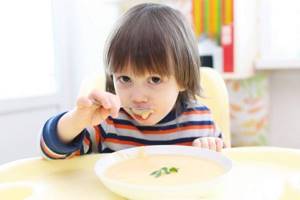
Pathogens
Intestinal infections are one of the most common diseases in children. Almost every third child gets sick in the summer. The peak incidence of intestinal infections occurs in the summer. Very often, a child can catch the disease after eating poor-quality food or poorly washed fruit.

Another common cause of the disease is ingestion of water from bodies of water while swimming. A baby splashing in a river or lake can taste the water. A small amount is enough for infection. At sea, the concentration of pathogens can also be very high.
If the reservoir has stagnant water, the risk of infection increases several times. In warm weather, various pathogenic bacteria actively grow and multiply in it.
The most common intestinal infections are caused by:
- Various types of viruses. These can be rotaviruses, adenoviruses and many other varieties. Once in the baby’s body, they quickly penetrate the bloodstream and cause infection. The development of the disease when infected with viruses is usually rapid (sometimes within 6-8 hours from the moment it enters the blood).
- Pathogenic bacteria. Infection with salmonella, shigella, dysentery bacillus, Proteus or E. coli is quite common. They usually cause severe watery diarrhea. The number of bowel movements can reach 10 times a day. The child becomes capricious and refuses to eat.
- Protozoa. They cause intestinal disorders much more often. The most common pathogens are amoeba or balantidium.
Children suffer from intestinal disorders much more often than adults. This is due to the imperfection of the structure of their digestive system. The child's immunity is very labile. It is not always able to withstand the aggressive effects of bacteria. If a child is weakened or has recently had any cold, he can easily become infected with an intestinal infection.
